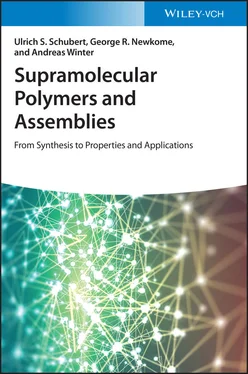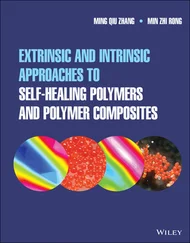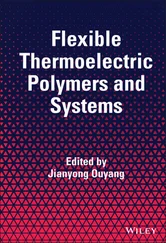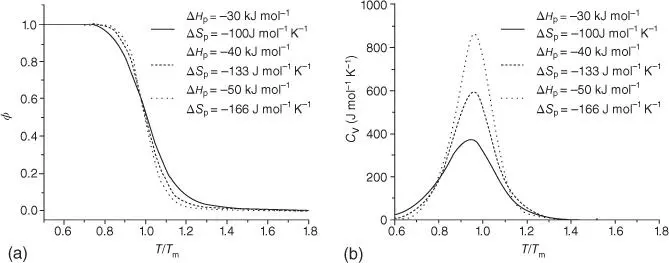
Figure 1.8 Illustration of the characteristic properties of a temperature‐dependent IDP according to the “free association” model: (a) fraction of polymerized monomers ( ϕ ) vs. T / T m(assuming fully flexible polymer chains and a cubic lattice); (b) heat capacity at constant volume ( C V) vs. T / T m. In both plots, the curves obtained for various enthalpy (Δ H p= −30, −40, and −50 kJ mol −1, respectively) and entropy values (Δ S p= −100, −133, and −166 J mol −1K −1, respectively) are shown; in all cases, the initial volume fraction of the monomers has been set to 0.1.
Source: Modified from Dudowicz et al. [50]; Douglas et al. [51].
In the field of supramolecular polymers, independent of the nature of the involved non‐covalent linkage, their formation via IDP is by far the most common mechanism. Many examples involving hydrogen‐bonding ( Chapter 3) or host–guest interactions (e.g. by crown ether or calixarene recognition; Chapters 6– 10) as well as metal‐to‐ligand coordination ( Chapter 4) are discussed there. It has to be pointed out that the determination of the molar mass of all these supramolecular polymers is generally nontrivial, since the established direct analytical methods commonly used for traditional, i.e. covalent, macromolecules (e.g. size‐exclusion chromatography [SEC] or mass spectrometry) can often not be applied due to the weak nature of the supramolecular bonds: already small changes in temperature, solvent composition, and concentration might lead to significant changes of the DP [60, 61]. However, several spectroscopic techniques (e.g. nuclear magnetic resonance (NMR) or UV/vis absorption), calorimetry, and analytical ultracentrifugation (AUC) can be applied in many cases to determine the molar masses [33, 36, 37]. A summary of the scope and limitations in characterizing supramolecular polymers is given separately in Chapter 12.
1.3.2 Ring‐Chain‐Mediated Supramolecular Polymerization
The so‐called ring‐chain‐mediated supramolecular polymerization represents the second main mechanism to describe the growth of supramolecular polymer chains ( Figure 1.4b). In general, a heteroditopic monomer is polymerized reversibly; this monomer as well as its oligomers and, eventually, polymer chains feature an equilibrium between a linear and a cyclic species ( Figure 1.9). Ring formation occurs via the intramolecular reaction of the end groups, whereas intermolecular reactions will accordingly give longer chains. Flexibility of the monomer represents, thus, a prerequisite for this type of mechanism; for instance, flexible alkyl or even polymer chains can be used to link the terminal supramolecular binding sites of such a monomer [62]. It is generally accepted that the covalent step‐growth polymerization of such monomers typically gives some wt% of macrocyclic oligomers (thereby, the polymerization can be performed under kinetic or thermodynamic control) [44, 63, 64]. Representatively, two classic cases in which also macrocyclic species are formed shall be named briefly: the bulk polymerization of triethylene glycol with hexamethylene–diisocyanate (polycondensation under kinetic control) [65] and, as an example for a thermodynamically controlled process, the catalyzed equilibrium polymerization of α , ω ‐disubstituted siloxanes (in particular, the later system was widely investigated by Scott [66], Brown and Slusarczuk [67], Carmichael and Winger [68], as well as Flory and Semlyen [69]). The entropically driven ring‐opening metathesis polymerization (ROMP) of cyclic olefins [70] and the ring‐chain polymerization of liquid sulfur [71–73] are further representatives for covalent ring‐chain polymerizations under thermodynamic control. As a general characteristic for a step‐growth polymer, the reversibility of bond formation establishes an equilibrium between macrocyclic and linear species. With respect to supramolecular polymers, where the formation/cleavage of non‐covalent bonds is typically fast, the macrocyclization pathway occurs always under thermodynamic control.

Figure 1.9 Schematic representation of the generalized mechanism of a ring‐chain‐mediated supramolecular polymerization. The intermolecular binding constants ( K inter) are related to the intermolecular association of molecules, whereas the intramolecular binding constant K intra(n‐mer)is assigned to the ring closure of monomers, oligomers, and polymers.
Source: Winter et al. [39]. © 2012 Elsevier B.V.
The first model to theoretically quantify the ratio of intra‐ and intermolecular association was provided by Kuhn already in the 1930s [74]: the effective concentration ( c eff) correlates the length of a polymer chain (thereby, taking the mean squared end‐to‐end distance and assuming Gaussian statistics) with the probability of the end groups to react, i.e. to undergo macrocyclization; the latter one was predicted to decrease by N −3/2( N denotes the number of bonds along the polymer chain [ Figure 1.10]).
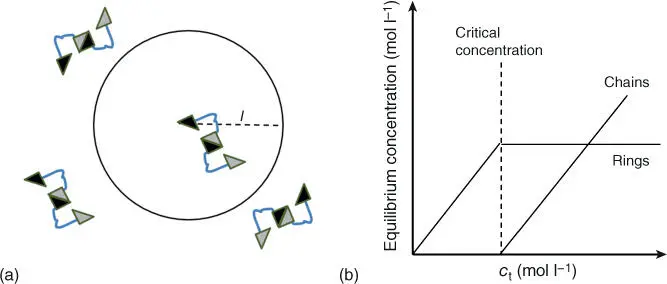
Figure 1.10 (a) Schematic representation of Kuhn's concept of effective concentration ( c eff) for a heteroditopic oligomer (i.e. having two different end groups, A and B) [74]. In solution, the end group A will experience an effective concentration of B, if the latter one cannot escape from the sphere of radius l , which is identical to the length of the stretched chain. Thus, the intramolecular association between the termini becomes favored for c effvalues higher than the actual concentration of B end groups. (b) Illustration of how the equilibrium concentration of chains and macrocycles can be correlated to the total concentration ( c t) of a ditopic monomer in dilute solution; such a ring‐chain supramolecular polymerization typically features a critical concentration.
Source: de Greef et al. [26]. © 2009 American Chemical Society.
The toolbox of polymer physics, in particular utilizing random‐flight statistics, enables one to calculate c effas a function of the length of the polymer chain [75]. In reasonably good approximation, the distribution function for random‐coil polymers is of Gaussian shape [62]; however, this model only holds true for long, flexible chains [76]. In the same context, a particle‐in‐a‐sphere model was utilized by Crothers and Metzger [77]. In a more realistic approach, Zhou employed a worm‐like chain model to determine c efffor short and, thus, semi‐flexible polypeptides [78, 79].
For practical reasons, the rather theoretical concept of effective concentration, which basically relies on concentrations calculated from the physical properties of the terminal functionalities, is often replaced by a more empirical concept using effective molarities [80–85]. The effective molarity (EM) is defined as the ratio of intra‐ and intermolecular equilibrium constants (i.e. K interand K intra, Eq. (1.4), see also Figure 1.9): cyclization is basically preferred for EM > 1, whereas linear chains are obtained for EM < 1. In addition, EM can be considered as a pure entropic correction, which becomes relevant when an intramolecular process replaces the analogous intermolecular one (however, this only applies to unstrained, flexible chains linking the end groups) [86].
Читать дальше
